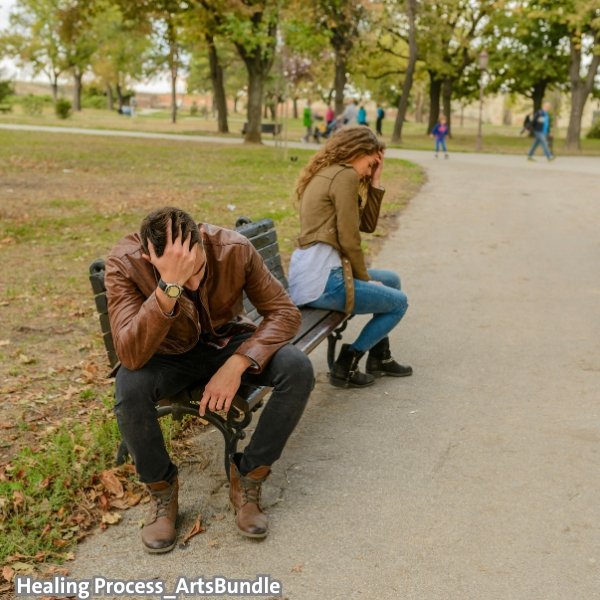The healing process after trauma or loss can be tough. This article looks at fifteen main reasons why many people prefer to “let go” rather than face their pain and start the process of emotional recovery, by many different factors.
1. The Illusion of Control

- The Misunderstanding:
- We believe that by dwelling on past events, we can alter them.
We think that focusing on the pain provides insights and prevents similar future hurt.
This creates a false sense of control as if our emotional attachment to the past grants us power over it. - The Truth:
The past is unchangeable.
Clinging to pain keeps us trapped in a cycle of rumination and hinders our healing process.
True control lies in acknowledging our powerlessness over the past.
We can regain control by directing our energy towards the healing process and growth in the present.
2. Changing the focus
Changing the focus by shifting the narrative:
- To truly heal, we must shift our focus from asking “why” we are hurting to considering “what can we do now” in our healing process.
- Instead of getting stuck in the past and worrying about “what if,” we should concentrate on the present and the steps we can take to support our healing process.
Taking Back Control:
This shift in focus helps us regain control over our lives and supports our healing process. We realize we have the power to make choices that affect our well-being today.
These choices may include:
- Seeking help: Joining therapy or support groups.
- Practicing self-care: Engaging in activities like exercise, mindfulness, and spending time in nature.
- Setting boundaries: Learning to say “no” to people or situations that hinder our healing process.
- Building self-compassion: Treating ourselves with kindness and understanding.
Living in the Now:
- By concentrating on the present, we can find purpose and meaning in our lives.
- We can learn to appreciate the beauty of the present moment and engage in activities that bring us happiness.
3. Fear of Re-experiencing Pain

- The Cycle of Avoidance:
The fear of feeling painful emotions can lead to a cycle of avoidance.
We may avoid situations, relationships, or thoughts that remind us of past trauma.
While this may feel protective, it can slow down our healing process. - The False Sense of Safety:
Staying numb might seem safer than facing the pain of healing.
However, this numbness often prevents us from growing emotionally and finding true happiness. - Facing the Fear:
To overcome the fear of feeling pain again, we need courage and self-kindness.
It’s important to recognize the fear without judging ourselves and to approach the healing process slowly and gently. - Finding Help:
Reaching out to a therapist or trusted friends can provide a safe space for support in our healing process.
4. Societal Pressure to “Move On”
Our culture tends to focus on being strong and returning to normal quickly after tough times. This pressure can make us feel like our pain doesn’t matter and push us to “move on” before we’re ready to heal. This can slow down real healing, which usually takes time and isn’t always a straight path.
Also read: Toxic Relationships: 4 Warning Signs and How to Reclaim Your Happiness.
5. The Appeal of Finality

The Desire for Closure:
- We often seek order and predictability.
- We long for a sense of finality—a clear end to our suffering and a resolution to tough times.
- This wish for closure is both natural and understandable.
Seeking Closure Through Different Means:
- Searching for answers: We may constantly look for explanations to unanswered questions.
- Reconciliation: We may strive for peace with those who caused us pain, even if it seems unlikely or unhealthy.
- Forgiveness: We may seek forgiveness from others and ourselves to find inner peace.
The Myth of Closure:
- While these actions can aid in healing, they often don’t provide the tidy closure we desire.
- True closure rarely comes in a straightforward or easily achievable package.
- Letting go can sometimes mean avoiding the complicated and unpredictable nature of healing.
- We may choose to “let go” of seeking closure, not because we’ve truly processed the past, but because we fear the uncertainty and discomfort that come with real healing.
Accepting the Chaos:
- Real healing often involves accepting the messiness and unpredictability of the journey.
- It involves recognizing that there may not be a simple resolution and that the path may include setbacks and surprises.
- Instead of aiming for a clear “closure,” we can focus on incorporating our past into our lives in a way that allows us to live fully without being defined by it.
6. The Comfort of the Known

Pain, even when it is very intense, can feel familiar. We might unknowingly fight against the healing process because it changes what we are used to, even if that situation is very painful. The fear of what we don’t know and the chance of facing new feelings can be too much to handle during our healing process.
7. Self-Blame and Shame
In many situations, we often hold ourselves responsible for the pain we feel. This self-blame can create feelings of shame and guilt, which makes it hard to ask for help or to be kind to ourselves—both important parts of healing. Sometimes, letting go can be a way to escape these difficult emotions.
8. The Illusion of Permanence
We might think that letting go means we have to forget or erase our past. But healing is not about forgetting; it’s about blending our past into our lives in a way that doesn’t limit us or define who we are. This blending is essential for healing.
9. Holding On Keeps the Pain Alive
Holding onto past hurts can keep emotional wounds open. By letting go, we can move past the pain and begin to heal, finding inner peace.
10. Letting Go Encourages Growth
Healing is not just about getting better; it’s also about growing. When we let go of what doesn’t help us, we make room for new experiences and personal growth, which are vital for healing.
11. Emotional Freedom Comes from Letting Go
Carrying emotional weight can hold us back. Letting go frees us from that burden, allowing us to live without the pain that hinders our healing.
12. It Builds Strength
Choosing to let go helps us become stronger. It shows us that we can face difficulties and come out stronger, even without closure. This strength is important for successful healing.
13. You Can’t Heal in the Same Space
Sometimes, the people, places, or habits that hurt us are still around. Letting go of these elements creates a space where true healing can happen.
14. Forgiveness Is for Your Benefit

Forgiveness doesn’t mean you forget; it means you free yourself from the past’s control. Letting go is a form of self-care and a crucial step in healing.
15. Letting Go Helps You Take Back Control
By releasing the grip of past experiences, you regain control over your feelings, actions, and future. This empowerment is a key part of the healing journey
The healing process isn’t about erasing the past; it’s about accepting it and moving forward. Letting go is not a sign of weakness but a powerful act of self-love and courage. When we let go, we don’t just heal—we thrive.
What are the primary reasons individuals often choose to “let go” instead of actively engaging in the healing process?
Fear of pain, societal pressure, illusion of control, and fear of the unknown.
How does the concept of “letting go” differ from genuine healing?
Letting go can be avoidance, while genuine healing involves active engagement, confronting emotions, and developing resilience.
What are some practical steps individuals can take to encourage genuine healing instead of simply “letting go”?
Seek professional help, practice self-compassion, create a supportive environment, and engage in self-care.





